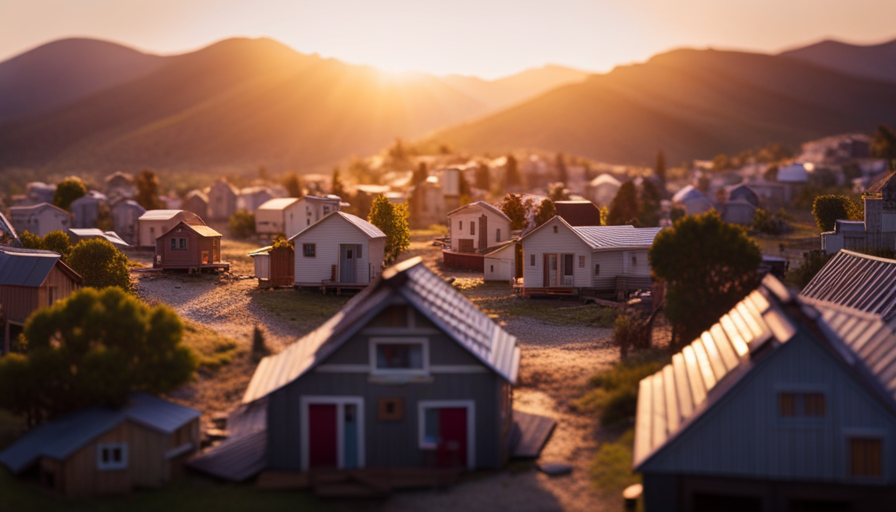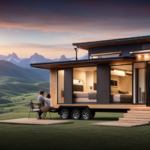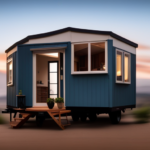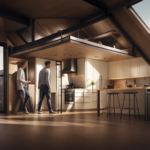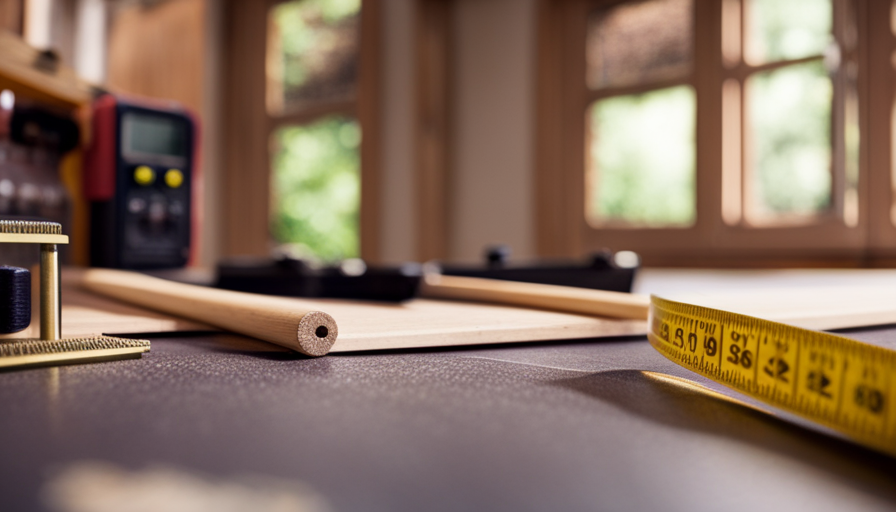In the realm of small houses, size is not the key factor. Larger tiny homes can offer the same amount of space and comfort as traditional homes, while still maintaining the charm and efficiency of their smaller counterparts.
In this article, we will explore what exactly defines a tiny house and delve into the world of size variations within this unique housing concept. From spacious layouts that maximize every inch of space to innovative designs that push the boundaries of what is possible, the largest tiny houses are a testament to the ingenuity and creativity of their architects and builders.
We will examine the challenges they face in creating these larger-than-life tiny homes, as well as the cost considerations that come along with them. Join me as we take a closer look at the world of large tiny houses and discover why these homes are becoming an increasingly popular choice for those seeking a simpler, more sustainable way of living.
Key Takeaways
- The largest tiny houses offer the space and comfort of a traditional home, despite their small size.
- Tiny houses typically range from 100 to 400 square feet, allowing for a minimalist lifestyle and reducing clutter.
- Downsizing into a tiny house brings benefits such as lower utility bills, maintenance costs, and a reduced environmental impact.
- Supersized tiny homes redefine the boundaries of tiny living, providing spacious layouts and creative storage solutions, although they may be more expensive to build and maintain.
The Concept of Tiny Houses
Have you ever wondered what the biggest tiny house is? When it comes to tiny houses, size restrictions play a big role in its concept. A tiny house is typically defined as a dwelling that is between 100 and 400 square feet in size.
The idea behind these small homes is to downsize and simplify, allowing for a more minimalist lifestyle. There are many benefits to downsizing into a tiny house. Firstly, it forces you to prioritize and only keep what you truly need, leading to a more clutter-free and organized living space. Additionally, the smaller size means lower utility bills and maintenance costs, which can be a huge financial advantage. Not to mention, the reduced environmental impact that comes with a smaller footprint.
Now, let’s explore the size variations within the world of tiny houses. While the typical tiny house falls within the 100 to 400 square feet range, there are some that push the boundaries and go beyond. These larger tiny houses often incorporate clever design features such as lofts or multi-purpose rooms to maximize space. By pushing the limits, these tiny houses offer a bit more comfort and flexibility while still adhering to the principles of downsizing.
Exploring Size Variations
Don’t you just love when you stumble upon a pint-sized dwelling that pushes the boundaries of what you thought was possible? When it comes to size variations in tiny houses, there are some truly remarkable examples out there that challenge the notion of limited space. These tiny houses manage to create spacious layouts that defy their compact dimensions.
Here are three examples of size variations in tiny houses that will leave you in awe:
-
The Expandable Tiny House: This innovative design incorporates collapsible walls and adjustable furniture, allowing the living space to expand and contract as needed. It’s like having a tiny house that can transform into a larger one whenever you desire.
-
The Multi-Level Tiny House: By utilizing vertical space effectively, these tiny houses incorporate loft areas or mezzanines, maximizing the available square footage. This clever design strategy creates the illusion of extra room and provides separate areas for sleeping, working, and relaxing.
-
The Tiny House on Wheels: Many tiny houses are built on trailers, allowing them to be mobile and easily transported. These mobile abodes come in various sizes and styles, catering to different needs and preferences.
With these size variations in mind, it’s fascinating to explore the world of the largest tiny house designs. It’s incredible how these dwellings can offer ample living spaces while still embracing the tiny house ethos.
The Largest Tiny House Designs
Get ready to be amazed by the expansive and awe-inspiring designs of these small yet surprisingly spacious dwellings. When it comes to the largest tiny house designs, architects and designers have truly pushed the boundaries of what can be achieved in a limited space.
These remarkable structures are a testament to human creativity and ingenuity in maximizing limited space.
One approach to creating a large tiny house is through clever floor plan designs. By strategically placing rooms and utilizing multi-purpose furniture, designers have been able to create homes that feel much larger than their actual square footage. For example, loft spaces are often used to maximize vertical space, allowing for additional living areas or storage.
Another way to maximize limited space in a tiny house is through the use of innovative storage solutions. From hidden compartments to built-in shelving, these designs prioritize functionality without sacrificing style. Every nook and cranny is utilized to its fullest potential, creating a home that feels organized and clutter-free.
These larger tiny house designs are not just about practicality, but also about comfort. Despite their small size, these homes are designed to be cozy and inviting. From comfortable seating areas to well-appointed kitchens and bathrooms, every aspect is carefully considered to ensure a comfortable living experience.
As we transition into the next section about spacious layouts for comfort, it’s important to note that even though these tiny houses may be small in size, they offer a surprising amount of space for all your needs.
Spacious Layouts for Comfort
Indulge in the luxury of expansive floor plans that provide a comfortable and inviting atmosphere for all your relaxation needs. When it comes to tiny houses, spacious layouts are key in maximizing the limited space available. With clever design choices and innovative solutions, these tiny houses offer a surprising amount of room without compromising on style or functionality.
One way to achieve a spacious design is through open-concept layouts. By removing unnecessary walls and barriers, the space feels larger and more connected. Additionally, incorporating multi-purpose furniture and storage solutions can help maximize every inch of space available. For example, a dining table that can be folded down when not in use or a sofa that doubles as a guest bed.
To give you an idea of the possibilities, here’s a table showcasing some practical design elements commonly found in spacious tiny houses:
| Design Element | Description | Benefits |
|---|---|---|
| Open-concept | Removes walls for a larger feel | Increased sense of space |
| Multi-purpose | Furniture with dual functions | Maximizes usability |
| Smart storage | Utilizes vertical and hidden areas | Keeps belongings organized |
With these spacious layouts, tiny houses can offer the comfort and functionality of a much larger home. Now, let’s delve into the world of supersized tiny homes and discover how they push the boundaries of what we thought was possible in a tiny living space.
Supersized Tiny Homes
Step into a world where small spaces become grand as supersized tiny homes redefine the boundaries of what we thought was possible. These innovative designs take the concept of tiny living to a whole new level, offering spacious layouts that can accommodate a growing family or provide ample room for entertaining guests.
The beauty of these supersized tiny homes lies in their ability to maximize every inch of space, utilizing creative storage solutions and clever design techniques. From multifunctional furniture to lofted sleeping areas, these homes prove that you don’t need a lot of square footage to live comfortably.
Of course, with the increase in size comes an increase in cost. Supersized tiny homes can be more expensive to build and maintain compared to their smaller counterparts. The larger footprint requires more materials and labor, driving up construction costs. Additionally, heating, cooling, and utilities may also be more expensive in these larger homes. However, for those who value the extra space and are willing to invest in a more substantial tiny home, the benefits can outweigh the cost implications.
As we delve into the next section about luxurious features in tiny houses, we will explore how these supersized designs can incorporate high-end amenities without compromising on functionality or style.
Luxurious Features in Tiny Houses
Welcome to the world of opulence in compact dwellings, where tiny homes transform into exquisite havens boasting lavish amenities and extravagant finishes. These luxurious features in tiny houses redefine the notion of stylish living in limited space. From state-of-the-art appliances to spa-like bathrooms, these tiny homes offer an array of luxury amenities that cater to the most discerning of tastes.
Innovative designs are at the forefront of these opulent tiny houses. Architects and designers have ingeniously maximized every inch of these homes to create a sense of grandeur. Take for example the three-column and three-row table below that showcases the stunning features found in these luxurious tiny homes:
| Amenities | Description |
|---|---|
| Rooftop Terrace | A private oasis above |
| Home Theater | An immersive cinematic experience |
| Gourmet Kitchen | High-end appliances and finishes |
These amenities, combined with clever storage solutions and high-quality materials, create a truly indulgent experience in a compact space.
As we explore the realm of sustainable design in large tiny houses, we will delve into the innovative ways these homes blend eco-consciousness with luxury living.
Sustainable Design in Large Tiny Houses
When it comes to sustainable design in large tiny houses, there are two key points to consider: energy-efficient systems and the use of eco-friendly materials.
Energy-efficient systems, such as solar panels and energy-saving appliances, can significantly reduce the environmental impact of a large tiny house.
Additionally, using eco-friendly materials, such as reclaimed wood and recycled insulation, can further enhance the sustainability of the design.
By incorporating these elements, large tiny houses can not only provide ample living space but also contribute to a greener and more sustainable future.
Energy-efficient systems
The largest tiny house has energy-efficient systems that help reduce its carbon footprint. It utilizes energy-efficient lighting, which not only consumes less electricity but also lasts longer, minimizing waste. Additionally, it incorporates renewable energy sources such as solar panels, harnessing the power of the sun to generate electricity. This not only reduces the dependence on fossil fuels but also lowers energy costs in the long run.
The use of energy-efficient systems in the largest tiny house showcases the commitment to sustainability and environmental consciousness. By incorporating these technologies, the house maximizes energy efficiency and minimizes its impact on the environment.
As we transition into the subsequent section about using eco-friendly materials, it is important to consider the holistic approach to sustainable design in large tiny houses.
Using eco-friendly materials
Utilizing eco-friendly materials is essential for creating a sustainable and environmentally conscious living space. When it comes to building a tiny house, there are various eco-friendly building materials and sustainable construction techniques that can be used.
For example, reclaimed wood is a popular choice as it reduces the need for new trees to be cut down. Additionally, recycled metal and glass can be incorporated into the design to minimize waste. Insulation made from recycled materials such as denim or cellulose can also be used to ensure energy efficiency.
By using these eco-friendly materials, not only can we reduce our carbon footprint, but we can also create a healthier living environment.
Transitioning into the subsequent section, it is important to consider the challenges of building and living in large tiny houses.
Challenges of Building and Living in Large Tiny Houses
Living in a large tiny house may present you with various challenges, such as limited storage space and the need to be creative with your interior design choices. However, these challenges can be overcome with careful planning and organization. Here are four challenges you may encounter when building and living in a large tiny house:
-
Building Codes: One of the main challenges of constructing a large tiny house is navigating building codes and zoning regulations. These regulations can vary from one location to another and may restrict the size and placement of your tiny house. It’s important to thoroughly research and understand these codes before beginning construction.
-
Limited Storage Space: Despite its larger size, a large tiny house still has limited storage space compared to a traditional home. This means you’ll need to be strategic about what you keep and how you organize it. Utilizing vertical storage solutions, such as shelves and hooks, can help maximize space.
-
Interior Design Choices: With limited square footage, you’ll need to carefully consider your interior design choices. Opting for multi-functional furniture, such as a sofa that can also be used as a bed, can help maximize the usability of your space.
-
Cost Considerations: Transitioning from the challenges of building and living in a large tiny house, it’s important to consider the cost implications. While it may seem counterintuitive, building a larger tiny house can actually be more expensive than building a smaller one. The cost of materials and construction may increase, and you may also need to invest in additional storage solutions and furniture.
Living in a large tiny house offers its own unique set of challenges, from navigating building codes to maximizing storage space. However, with careful planning and consideration, these challenges can be overcome, allowing you to enjoy the benefits of a larger tiny house.
Now, let’s explore the cost considerations of large tiny houses.
Cost Considerations of Large Tiny Houses
Building and living in large tiny houses certainly present their fair share of challenges. From finding suitable land to navigating zoning regulations, there are many obstacles to overcome. However, one of the most significant considerations when it comes to large tiny houses is the cost.
A cost analysis of building and living in large tiny houses is crucial to understanding the financial implications. While the initial investment may be higher due to the larger size and additional materials required, there are potential long-term savings to consider. For instance, larger tiny houses often come with more storage space and amenities, reducing the need for external storage units or renting additional space. Additionally, the cost of utilities and maintenance can be lower compared to traditional houses.
However, it’s essential to carefully evaluate the overall budget, including construction, land, and ongoing expenses. It’s also crucial to consider the potential resale value of a large tiny house if one decides to move or downsize in the future.
Considering the cost implications of large tiny houses, it’s evident that careful planning and budgeting are necessary.
Now, let’s delve into the future of tiny house living and explore how this trend is shaping our housing landscape.
The Future of Tiny House Living
With the rising popularity of compact dwellings, it’s fascinating to note that the number of people opting for smaller, more sustainable housing options has increased by 67% in the past decade. This trend towards downsizing has led to numerous innovations in the tiny house movement, and the future looks promising for those interested in this alternative lifestyle.
One of the key future innovations in tiny house living is the integration of smart technology. As technology continues to advance, we can expect to see tiny houses equipped with smart home features, such as voice-activated controls, energy-efficient appliances, and automated systems for heating, cooling, and security. These advancements will not only increase convenience but also reduce energy consumption, making tiny houses even more sustainable.
Another exciting development is the emphasis on community living within the tiny house movement. Many people are now choosing to live in tiny house communities, where like-minded individuals come together to create a supportive and sustainable environment. These communities often share resources, such as communal gardens, workshops, and common areas, fostering a sense of belonging and cooperation.
The future of tiny house living holds great potential for innovation and community building. With advancements in smart technology and the growing popularity of tiny house communities, individuals opting for smaller, more sustainable housing options can look forward to a future that is both efficient and socially connected.
Frequently Asked Questions
How do tiny houses contribute to sustainable living?
Tiny houses contribute significantly to sustainable living by offering numerous benefits and minimizing environmental impact. These compact dwellings promote a minimalist lifestyle, reducing the consumption of resources such as energy, water, and materials. They often utilize renewable energy sources and incorporate energy-efficient technologies, further decreasing their carbon footprint.
Additionally, tiny houses encourage individuals to live more consciously, fostering a sense of community and connection to nature. Overall, their small size and eco-friendly features make them an excellent choice for sustainable living.
What are some common challenges faced when building and living in large tiny houses?
When building and living in large tiny houses, there are several common challenges that arise.
One major hurdle is navigating building regulations, as many areas have size restrictions on dwellings. This can require creative design solutions to maximize space within these constraints.
Additionally, space optimization becomes crucial in larger tiny houses, as every square inch counts. Effective storage solutions and clever design choices are needed to make the most of the available space and create a comfortable living environment.
Are there any luxurious features available in tiny houses?
Luxurious amenities and stylish interior designs are available in tiny houses, making them feel like cozy retreats. From spa-like bathrooms to gourmet kitchens, these small homes offer a taste of luxury. The use of high-end materials, clever storage solutions, and well-designed layouts maximize space and create a comfortable living environment. Incorporating features such as smart home technology and designer furnishings adds an extra touch of elegance. Living in a tiny house can be a truly indulgent experience.
How much does it cost to build and maintain a large tiny house?
To build and maintain a large tiny house, the cost of materials can vary depending on the design and materials chosen. Generally, the cost of materials for a larger tiny house can range from $30,000 to $100,000.
As for utilities, the cost will depend on factors such as location, energy efficiency, and personal usage. On average, monthly utility costs for a large tiny house can range from $100 to $500.
What does the future hold for the tiny house living movement?
What does the future hold for the tiny house living movement?
As the demand for affordable and sustainable housing increases, it’s clear that the tiny house movement will continue to grow.
Future trends in tiny house living include innovative designs that maximize space and functionality, as well as the use of eco-friendly materials.
Moreover, the social impact of this movement can’t be ignored, as it promotes a simpler and more minimalist lifestyle, fostering a sense of community and reducing our carbon footprint.
So, are you ready to join the tiny house revolution?
Conclusion
In conclusion, exploring the world of tiny houses has taken me on a journey of discovery. From the concept of compact living to the largest tiny house designs, I’ve seen how these small spaces can be transformed into spacious havens.
The challenge of building and living in large tiny houses isn’t to be underestimated, but the rewards of sustainable design and cost considerations make it all worthwhile.
As I envision the future of tiny house living, I see a world where these tiny homes continue to grow in size, while still maintaining their charm and efficiency.
Hi, I’m Emma. I’m the Editor in Chief of Tiny House 43, a blog all about tiny houses. While tree houses are often associated with childhood, they can be the perfect adult retreat. They offer a cozy space to relax and unwind, surrounded by nature. And since they’re typically built on stilts or raised platforms, they offer stunning views that traditional homes simply can’t match. If you’re looking for a unique and romantic getaway, a tree house tiny house might just be the perfect option.
